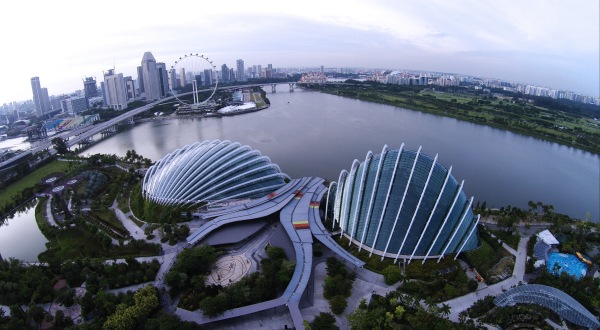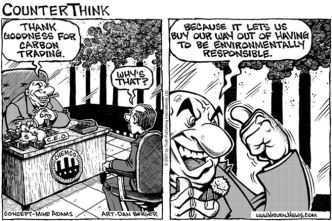Paris Agreement inches closer to entry
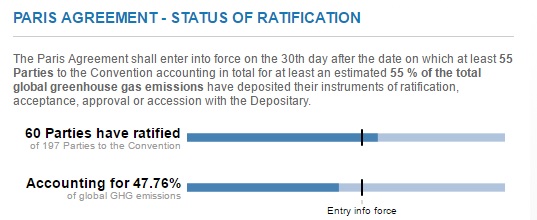
Yesterday at a special “High-Level Event on Entry into Force of the Paris Agreement on Climate Change” convened by UN Secretary-General Ban Ki-Moon, 31 countries including Singapore formally joined the Paris Agreement, moving the landmark deal closer to entry into force.
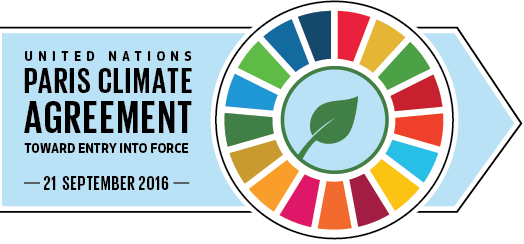
The Agreement is inching towards entry into force as 60 countries accounting for 47.5% of the world’s emissions have deposited instruments of ratification to the United Nations.
31 countries deposited instruments of ratification of the Paris Agreement yesterday:
- Albania (0.01%)
- Antigua and Barbuda (0.002%)
- Argentina (0.8%)
- Bangladesh (0.4%)
- Belarus (0.16%)
- Brazil (2.5%)
- Brunei Darussalam (0.04%)
- Chile (0.2%)
- Dominica (0.0006%)
- Guinea (0.062%)
- Honduras (0.1%)
- Iceland (0.005%)
- Kiribati (0.0001%)
- Madagascar (0.125%)
- Mexico (1.6%)
- Mongolia (0.128%)
- Niger (0.056%)
- Panama (0.047%)
- Papua New Guinea (0.21%)
- Senegal (0.061%)
- Singapore (0.1%)
- Sri Lanka (0.098%)
- Swaziland (0.006%)
- Thailand (0.8%)
- Uganda (0.1%)
- UAE (0.46%)
- Vanuatu (0.001%)
These countries bring the total emissions coverage to 47.7%, just a few points shy of entry.
The remaining percentage of emissions coverage needed to take the Paris Agreement over the threshold to entry could come from the European Union which accounts for 12% of global emissions. Alternatively, major emitters such as the Russian Federation which accounts for 5% of global emissions, Indonesia (4.3%), India (4.1%), Japan (3.6%), Canada (1.6%), Australia (1.48%) or South Korea (1.4%) could also contribute to meeting the last few percentage points.
Secretary Kerry Delivers Remarks at the U.N. Paris Agreement Entry Event
U.S. Secretary of State John Kerry participates in the UN Paris Agreement Entry into Force, at the UN General Assembly Hall, in New York City on September 21, 2016.
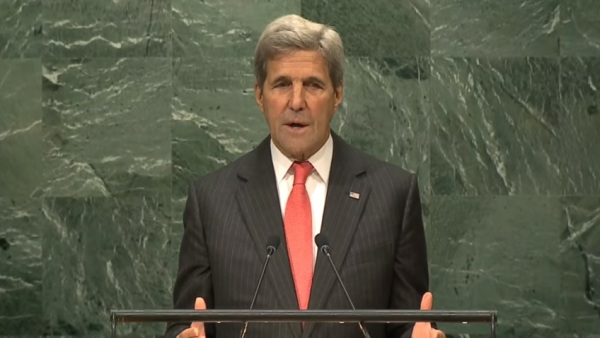
Watch video here.
The Climate Change Experiment
After reading the extra credit dilemma that went viral online, I decided to try it on my class of 35 Geography students to teach the topic of climate change.

The results: A third of the class voted for 6 points in Round 1. Half the class voted for 6 points in Round 2. Unfortunately for the students, none of these points were real.
CCaSS works with companies on their climate change and sustainability strategies, with a range of services including advisory, verification of carbon emissions and the carbon footprint of companies. They help companies create a sustainability framework, advise companies on their risk management systems and implement programs. These help a company with sustainability reporting.
The hope is that compulsory sustainability reporting will drive companies to start, or continue to improve on their business’s sustainability. However, companies may feel that sustainability reports are just one more overhead for the company to bear, making it a burden instead. Mr Sadashiv rebuts this perspective, saying that sustainability is part and parcel of running the business. He gives the example of General Electric’s Ecomagination, which produces cars, and products with green technology that are higher priced than their regular products. Innovation will breed competitiveness, which is a good thing. Companies can show their customers they are environmentally conscious while also making profits.
Singapore could take cues from the Scandinavian countries that are driving the trend towards exhibiting responsible behavior, whether toward climate change or other environmental issues. Mr Sadashiv believes ASEAN is at the starting block as there is evidence of positive commitments happening at the governmental level (such as the INDCs), but the speed at which these regulations are implemented is much slower. With compulsory sustainability reporting it will happen in fits and starts, depending on whether companies see it as a reporting burden or an asset.
Ideally, there should be a push toward sustainable behavior before pushing sustainability reports. Singapore is a society which over consumes. For example, a handphone contains rare Earth material that constitutes tons of earth dug up to make it, yet the pricing system for handphones is designed to drive the consumer to replace it every 18 months. Many people don’t recycle their handphones and have 3-4 in a drawer somewhere that they don’t use. Other problems Singapore faces:
- Waste Separation is an issue for us due to the way HDBs have been built.
- We are addicted to air conditioning. How do we encourage people to convert to fans, which are actually healthier for us?
- Prices for repairing dryers (and other household appliances) make buying a brand new model more worthwhile than repairing it, and this is done on purpose because that’s the company’s strategy.
- Pulau Semakau may run out of space to put our waste but no one seems to be worried about this.
So what exactly is lacking in Singapore culture?
Mr Sadashiv says, “An appreciation of how what we do in everyday existence links to the wider world or bigger problem of waste.”
This sounds very much like what companies should consider when it comes to climate change and sustainability: “What, due to my operations, are the externalities I should consider? What is the impact I’m having?”
What should SGX sustainability reporting include?
- Material matters/issues–expecting the company to declare the framework they’re using for reporting their energy, waste, water, etc.
- Stakeholder engagement (verified by the stakeholders). Global Reporting Initiative (GRI) defines stakeholders as those who have an impact on the company, and vice versa.
- Need to have policies and procedures in place.
- Set targets for the material matters that have been identified.
- Most importantly, the board of directors sign off to endorse the sustainability report.
Setting targets is tricky because companies worry about whether it is practical to have an annual target to meet. From a sustainability perspective, a long-term ambitious target makes more sense than a short-term target, as you may have to wait for technology to catch up.
Overall, it seems to boil down to people and companies living in a way that involves taking responsibility for the consequences of their actions. Sustainability reporting is one measure to motivate companies, but there needs to be a fundamental push on the individual in society to practice sustainable behavior as well.
Further Reading:
E&Y Analysis of the Top 50 SGX companies and their state of sustainability reporting at present
Climate Change and Hollywood – What’s the link?

The Revenant
It’s Oscars week in Hollywood! The main issue the Oscars grappled with this year is race and the lack of diversity in Oscar nominations, thus the #OscarsSoWhite hashtag (and well-founded). However, another issue lurked beneath the glossy post-produced films. Six-times nominated and first-time Oscar winner Leonardo DiCaprio (finally!) gave a shoutout to climate change in his Oscar acceptance speech:
Making The Revenant was about man’s relationship to the natural world — the world that we collectively felt in 2015 as the hottest year in recorded history. Our production had to move to the southernmost tip of this planet just to be able to find snow.
Climate change is real, it is happening right now, it is the most urgent threat facing our entire species, and we need to work collectively together and stop procrastinating.
We need to support leaders around the world who do not speak for the big polluters or the big corporations, but who speak for all of humanity, for the indigenous peoples of the world, for the billions and billions of underprivileged people who will be most affected by this, for our children’s children, and for those people out there whose voices have been drowned out by the politics of greed.
I thank you all for this amazing award tonight. Let us not take this planet for granted; I do not take this night for granted.
—Leonardo DiCaprio, Oscar Acceptance Speech
The Revenant (2015), a film about the legendary fur trapper Hugh Glass, features snowy landscapes and takes place, for the most part, out in nature. The decision to shoot only in natural lighting meant the cast and crew would be surrounded by the elements throughout the production. And while it seems the wonders of CGI today knows no bounds, the crew instead shot on-location surrounded by snow. But snow itself proved elusive, with weather predictions turning… well, unpredictable. The cast and crew had to shift from Canada to Argentina just to be where the snow was, even resorting to snowmakers (machines which churn out manmade snow). They had to compete with Tarantino’s latest film The Hateful Eight (2015) for the snowmakers, as it also features snowy landscapes, except it one-upped them by including a blizzard (although The Revenant does have a vicious bear… we’ll call it even).

The Hateful Eight
Since its inception, film has had a close relationship with realism. For what is the camera but a means of recording reality (and existence)? This is what some film theorists (ahem, Siegfried Kracauer) would say. Italian neorealist films such as De Sica’s The Bicycle Thief (1948) took realism as a gold standard, shooting on-location on busy streets, often with curious passers-by gazing into the lens of the camera.
That is to say, film production crews are in a unique position. Many times, they will see and feel the first-hand effects of climate change as they travel around to scout locations. By necessity of the script, a lot of film production depends on weather and climate. Judging from the problems encountered by The Revenant and The Hateful Eight’s crew, scriptwriters will likely have to be more discerning when choosing to include snowy landscapes in the future.
For more details and further reading, check out Vanity Fair’s article on ‘How Extreme Weather is Melting Hollywood’s Winter Shoots‘.
Ice Watch Paris – The Clock is Ticking
From my visit to the Arctic last year I have a very lively memory of the horrifying noise and sight of huge ice blocks cracking and breaking away from the pack. The Arctic is indeed the gatekeeper of climate disorder: for years, this region has been sending us signals that we cannot neglect anymore. The international community must hear them and turn them into acts.
- Laurent Fabius, French Minister of Foreign Affairs and International Development, President of COP21
They said that an image is worth a thousand words. This might be the easiest 3,000 words that I might ever write.
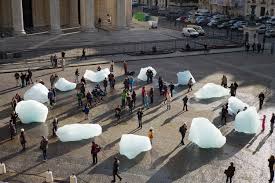 Photo Credits: http://icewatchparis.com/
Photo Credits: http://icewatchparis.com/
Denizens of affluent cities (like Singapore) lament the warmer weather and compensate by the extended use of air-conditioners indoors and Ray-ban shades when we step out. There are many others for whom such substitutes or adaptation measures don’t exist. In fact warmer temperatures impact their livelihoods and their very existence in extreme cases. We adapt to thrive whilst they struggle to adapt, even to survive.
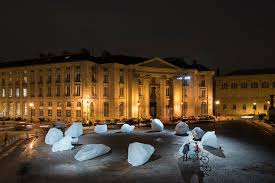
Photo Credits: http://icewatchparis.com/
Ice melts when heated. Every 10 year old knows that. When glacial ice melts in the Artic, the sea-levels rise and if all this ice melts, sea-levels will rise by 7 meters. While this might be a little far-sighted, let’s assume the scenario of a modest 2 meter rise in sea-levels. High-rise buildings and a mandate to raise the minimum reclamation levels by an additional 1 meter on top of the previous level of 1.25 meters above the highest recorded tide level observed should keep the inhabitants of Singapore safe. We’ll Survive.
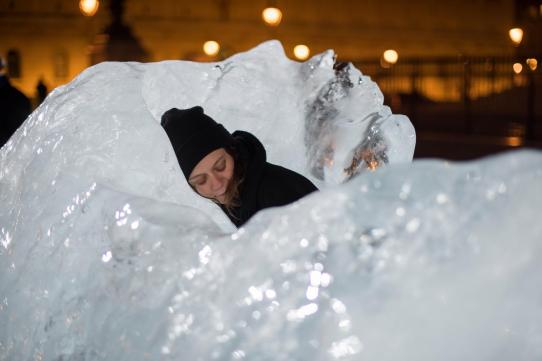
Photo Credits: http://olafureliasson.net/archive/artwork/WEK109190/ice-watch
Without food, we will die. Agriculture represents one of the most climate-sensitive industries. A small variation in rainfall will impact crop cultivation and yield. Adverse weather patterns and an uplift on global sea levels will destroy crops, cattle and our food supplies as a result. Most of what we eat in Singapore is imported from the very countries that are threatened by adverse climate impacts. What happened to surviving?
These problems and consequences specified above are just the tip of the iceberg. There is still time for us to do something about this crisis. Everyone one of us. The melting icebergs in the Artic are not that far off after all.
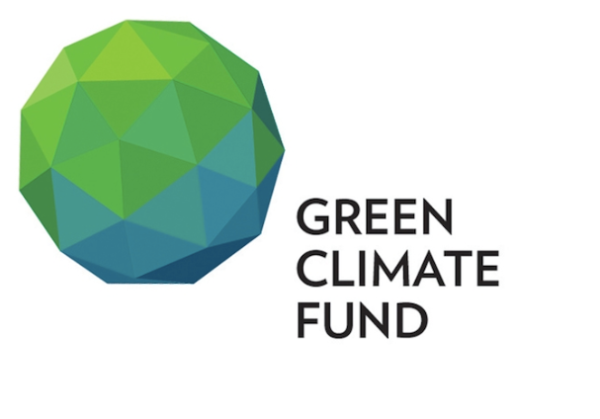
Picture source: The Green Climate Fund
On a side event organized by The Green Climate Fund on 2 December, speakers explained how GCF will go about identifying and prioritising investment opportunities and set out the criteria that the Board will use in making funding decisions.
The Green Climate Fund has approved its first 8 projects in the Fund Board’s first round of investment decisions in November and gives a good flavour of what the fund can do. The projects approved varies from a good mix of purposes like adaptation, mitigation, government, private etc.
The Board has developed criteria to prioritise investment decisions so that it can match its ‘paradigm shitfting’ level of ambitions.
Alberto Paniagua, CEO of PROFONANPE, the Peruvian Trust Fund for National Parks and Protected Areas suggested that good GCF projects should balance resource conservation with mitigation and adaptation measures. In order for projects to be more effective, he stressed the importance of building up experience.
Having been recently accredited by the Fund, Rwanda’s Minister of Natural Resources Vincent Biruta credited this significant achievement to the Ministry’s focus on environment and climate change at the heart of Rwanda’s development. The accreditation was also possible because Rwanda had identified its challenges, set specific goals, and put in place the frameworks.
Some panellists also spoke about the potential and importance of the GCF to reach their goals.
As a means of building resilience in face of threats to groundwater as a result of rising sea levels, Ambassador Amjad Abdullah of the Maldives explained how GCF-funded water management projects would provide safe and secure freshwater to the people in the northern atolls of Maldives.
Mexico’s first projects approved by the fund, elaborated by the Vice Minister of Environmental Policy and Planning Rudolfo Lacy Tamayo, through its pilot role within the Latin American and Caribbean energy efficiency green bond programme will go towards funds for small-scale energy efficiency projects for a wider range of investors.
The Fund, moving forward, will need to scale up its investments. It also stands ready to support the implementation of the INDCs and welcomes developing countries’ ambitious and effective projects to the Fund for the Board’s considerations.
Adapted from: http://www.greenclimate.fund/-/gcf-side-event-asks-what-makes-a-good-projec-2?inheritRedirect=true&redirect=%2Fhome
Migration Woes
“We are living in an era of forced mobility.”
– William Lacy Swing, Director-General of the International Organization for Migration
As Yilin rightly pointed out in a previous post, migration, or “human mobility”, has become the new buzzword in climate change negotiations. More people, in particular in developing regions of the world, are getting displaced by the day due to climate-induced changes such as droughts and conflicts. There is an urgent need for better research, data and capacity building to address issues related to human migration in the coming years.
I attended a side event in Paris that consisted of two consecutive panels, each with 5 high-profile speakers who discussed the drivers of the problem, its impacts, and the measures urgently needed to address it. But exactly how serious is the issue?
Consider Bangladesh. According to the 5th Assessment Report by the Intergovernmental Panel on Climate Change (IPCC), the country has been losing 6% of its Gross Domestic Product per annum due to storms alone, while a one-meter rise in sea level would likely result in the covering of 1/6 of its total land mass. Worldwide, up to 2.5 billion people will be living in areas subjected to intense drought by 2025. These all mean serious business that would have consequences beyond the national level; the displaced will find their way elsewhere, as the current case of the conflict in Syria has already shown.
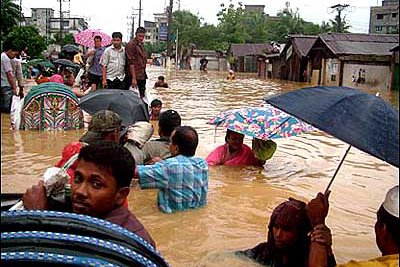
People displaced from their homes after a storm in Bangladesh. (Source: http://www.go-green.ae/green-column.php?aid=100)
On this basis, United Nations Assistant High Commissioner for Refugees Volker Türk emphasized that global environmental challenges have become “breeding grounds” for social tensions. The issues also tend to be highly politicized amidst calls for compassion in dealing with any refugees.
What is needed? The experts are optimistic that we can increase opportunities for land-based investments to develop resilient communities. According to Assistant Secretary-General for Humanitarian Affairs in the UN Office for the Coordination of Humanitarian Affairs (OCHA) Kang Kyung-Wha, this means investing in education of the people to increase capacity and to empower the most vulnerable to more effectively respond to crises. This also means shifting towards crisis risk management away from crisis response, to focus on minimizing the unforeseeable risks by preparing well ahead and to manage risks already known to us. Thus development planning has to ensure that all possible scenarios are considered, and to ensure that people have the means to obtain assistance to avoid displacement.
Overall, the issue on climate migration is complicated and multi-faceted. For one, a direct causation between climate change and the migration of people is difficult to establish. Many factors ultimately determine an individual’s movement beyond his or her homeland. This is nonetheless an emerging research field to explore in further detail at future COPs.
Understanding Climate Change induced Migration
At COP21, I attended a side event on the importance of social science research on climate induced migration. Having had a vague understanding of it prior to that, I learnt alot from the speakers and it sparked an interest inside me to know more about this area. This post will briefly highlight some areas of climate change induced migration.
Natural disasters alone have caused about 19.3 million people worldwide to be displaced from their homes in 2014 and 90% of it are weather-related events. The extreme weather- intense rains, typhoons and climate variability (affecting agriculture) have forced people to move elsewhere, mostly within their own countries, with some, though rarely, crossing international borders. There is a multi-causal relationship explaining climate induced migration; while there is a connection between the movement of people and natural disasters, climate change is one of the several factors causing it, rather than it being a direct cause.
Migration as a form of Adaptation
The term ‘migration’ has been viewed as a negative phenomenon, with deep historical and colonial ties, and caused as a reactionary response after a disaster.
The two main responses to climate change are mitigation and adaptation. Traditional forms of adaptation are ‘hard’ measures like building defences to protect against sea-level rise and developing drought-resistant crops.
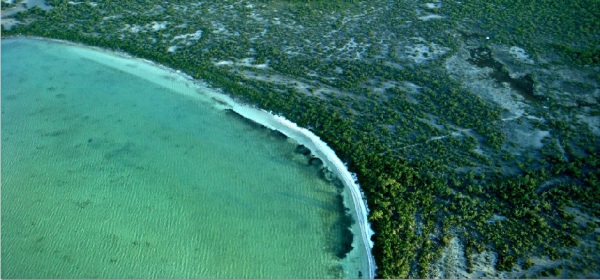
Picture source: https://www.adaptation-fund.org/belize-marine-resource-protection-adatation-project-approved/
With displacement occurring due to natural disasters and environmental related factors, climate change could increase the frequency and need for migration. Thus scholars feel that it is important to recognise migration as a form of adaptation strategy.
The issue with migration
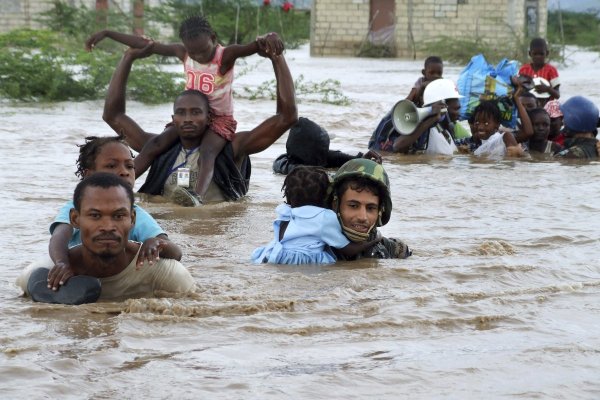
Picture source: https://www.unitar.org/ny/node/162
The term ‘refugee’ is used for people forced to leave their homes because of war, persecution or other violence. A person seeking refuge from an environmental disaster cannot apply for the refugee status and lacks protection under the U.N. High Convention for Refugees.
Migration is a complicated issue as it also involves border politics and arouses patriotic and xenophobic feelings.
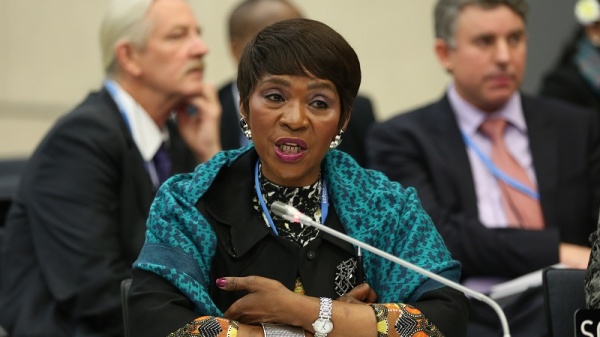
Picture source: un.org
In October 2015, the poor and developing nations known as the Group of 77 and China submitted a proposal for the Paris talks to deliver a plan for climate migrants. However, industrialised countries are wary about talks of migration or having to compensate those affected by climate change.
‘Displacement’ in the Paris Agreement
Before Paris, there was no mention of displacement or migration linked to climate change. Now, there is an agreement for countries to address displacement linked to climate change impacts.
The outcome to the Paris negotiations creates a “task force” whose job will be to “develop recommendations for integrated approaches to avert, minimize and address displacement related to the adverse impacts of climate change”
Though not as ambitious as some would have hoped, it is a start to a process that would address these climate change induced migration.
Sources:
- “Migration as adaptation: exploring mobility as a coping strategy for climate change” report; Kayly Ober; http://climatemigration.org.uk/category/resources/
- http://climatemigration.org.uk/alex_randall-paris-displacement-and-migration-what-happens-next/
- http://www.cbsnews.com/news/climate-change-migration-displacement-refugees/
- http://www.theguardian.com/commentisfree/2015/aug/18/mass-migration-crisis-refugees-climate-change
Carbon Offsets – Boon or Bane?
“Offsets are merely permissions to pollute for corporate entities!” she exclaimed.
Photo Credits: https://www.cartoonstock.com/cartoonview.asp?catref=lpen7
My present work in the project delivery team at Sindicatum Sustainable Resources “Sindicatum” enables me to have a deeper insight on two key approaches to addressing the climate crisis; Mitigation and Market Mechanisms. The former abates the impacts of climate change by reducing emissions fast enough to achieve the temperature goal – Sindicatum is developer, operator & owner of clean energy projects worldwide. These projects reduce the need for carbon-intensive fossil fuel based energy, thereby reducing the quantity of Greenhouse Gases (“GHG”) released into the atmosphere.
A market mechanism on the other hand, is a key instrument used to implement a carbon price that enables the transformation to a pathway of low-carbon and climate resilient economies. Market mechanisms or Emission Trading Schemes (“ETS”) to be exact play a critical role in stabilising anthropogenic emissions in the most cost-effective manner.
I was ready to engage my recent acquaintance from Puerto Rico in a debate to highlight the benefits of ETS but I needed a key ingredient before we commenced – Caffeine! The Paul Cafe right across Hall 4 in Le Bourget would come to my rescue and provide a good venue for us to continue this conversation.
“Hot chocolate for the lady and a cappuccino with an extra shot for me please. Merci Beaucoup!”
Part 1 – What is Emissions Trading and how does it work?
This “Cap-and trade” system is a market-based approach to resolve the climate conundrum. As the phrase suggests, this mechanism is comprised of two parts: The CAP and the TRADE.
Cap
The core tenet of the cap involves setting a ceiling or a limit on the total quantity of GHG emissions to be released into the atmosphere by entities within a geographical boundary over a period of time. Each allowance is equivalent to one tonne of carbon dioxide equivalent. Every participant in the scheme receives allowances that permit them to release the equivalent amount of GHG into the air that we breathe.
Trade
The trading aspect establishes a market for these permits by allowing entities to buy and sell depending on whether they have a shortfall or surplus in allowances. This provides incentives for companies to consistently find ways to reduce emissions from their operations or resort to accruing additional expenses in the form of purchasing allowances or carbon credits to account for their additional carbon footprint. The limit or the cap is reduced over time to ensure that aggregate emissions fall below allowable levels whilst also ensuring that these entities become more efficient in negating their impact on the environment.
Carbon Credits
Carbon credits are units (or commodities) that represent the emission reductions that arise from GHG abatement projects around the world. Whilst climate change is a global problem with profound immediate and long-term impacts, the impacts and the costs required to mitigate them are not equally distributed. It does not make a difference to planet Earth where the emission reductions are made and GHG abatement projects in developing countries optimize this process. To elaborate this with an example, it would be much cheaper and efficient to develop a Landfill-gas-to- energy project in Thailand as compared to one in the UK but regardless of where the project is developed, Earth’s denizens reap the benefits of reduced GHG emissions in the atmosphere.
The Defining Concept – Additionality
To qualify as a genuine carbon offset, the emission reductions achieved by the project would have to be beyond what would have occurred if the project was not implemented – Business-as-Usual. If a project is viable on its own accord either via electricity revenue, Government funding & mandates and policies, then this does not qualify as an offset project as it would have occurred regardless of the finance secured through carbon markets. These carbon offsets are means of channelling finance to low-carbon and emissions abatement projects that would not have occurred as per the baseline scenario. These projects MUST represent net environmental benefits to guarantee that the project activities will lead to a reduction of GHG into the atmosphere. These net benefits are further validated and verified by 3rd party independent organizations with the support of robust methodologies and genuine carbon standards.
How can I be certain that an emission reduction is real?
Robust carbon standards with independent verified assessments of the emission reductions produced by a project provide assurances that the emission reductions are real, quantifiable and additional. There are “premium” accreditations such as the Gold Standard that incorporates stringent methodology requirements for sustainable development in the local communities. As a result, local communities not only experience environmental benefits but also technology and skills transfer, improved safety, job creation for the local population and indirect economic benefits to name a few.
“Yes, I get how the mechanism works, but nowhere does it explain the escape route that it provides for these dirty companies to just pay their way out! Plus guess what I just saw earlier?”
Photo Credits: http://www.naturalnews.com/027676_carbon_trading_emissions.html
Yes, I am getting to the benefits of carbon offsetting right after this and I might as well debunk a few misguided perceptions about carbon credits. Let’s do this in three additional parts where (i) I’ll tell you a little bit more about Carbon markets and its benefits, (ii) other carbon pricing instruments and (iii) maybe a glimpse on what we can expect post-2020. Right now I want to get tips on getting those killer biceps from Mr. Arnold Alois Schwarzenegger. Help me return the Eco-Cup back will you?
